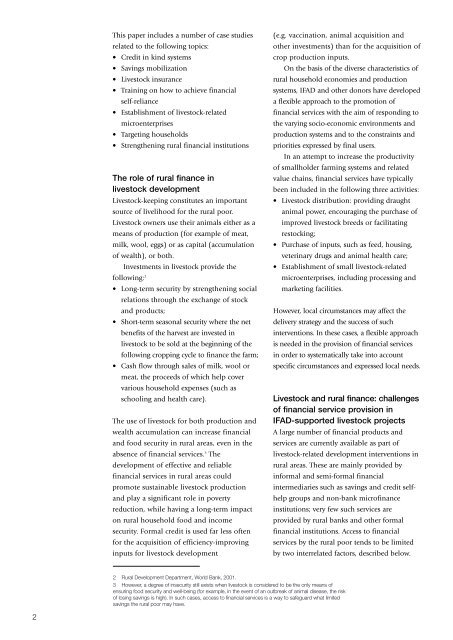Livestock and rural finance - IFAD
Livestock and rural finance - IFAD
Livestock and rural finance - IFAD
You also want an ePaper? Increase the reach of your titles
YUMPU automatically turns print PDFs into web optimized ePapers that Google loves.
This paper includes a number of case studies<br />
related to the following topics:<br />
• Credit in kind systems<br />
• Savings mobilization<br />
• <strong>Livestock</strong> insurance<br />
• Training on how to achieve financial<br />
self-reliance<br />
• Establishment of livestock-related<br />
microenterprises<br />
• Targeting households<br />
• Strengthening <strong>rural</strong> financial institutions<br />
The role of <strong>rural</strong> <strong>finance</strong> in<br />
livestock development<br />
<strong>Livestock</strong>-keeping constitutes an important<br />
source of livelihood for the <strong>rural</strong> poor.<br />
<strong>Livestock</strong> owners use their animals either as a<br />
means of production (for example of meat,<br />
milk, wool, eggs) or as capital (accumulation<br />
of wealth), or both.<br />
Investments in livestock provide the<br />
following: 2<br />
• Long-term security by strengthening social<br />
relations through the exchange of stock<br />
<strong>and</strong> products;<br />
• Short-term seasonal security where the net<br />
benefits of the harvest are invested in<br />
livestock to be sold at the beginning of the<br />
following cropping cycle to <strong>finance</strong> the farm;<br />
• Cash flow through sales of milk, wool or<br />
meat, the proceeds of which help cover<br />
various household expenses (such as<br />
schooling <strong>and</strong> health care).<br />
The use of livestock for both production <strong>and</strong><br />
wealth accumulation can increase financial<br />
<strong>and</strong> food security in <strong>rural</strong> areas, even in the<br />
absence of financial services. 3 The<br />
development of effective <strong>and</strong> reliable<br />
financial services in <strong>rural</strong> areas could<br />
promote sustainable livestock production<br />
<strong>and</strong> play a significant role in poverty<br />
reduction, while having a long-term impact<br />
on <strong>rural</strong> household food <strong>and</strong> income<br />
security. Formal credit is used far less often<br />
for the acquisition of efficiency-improving<br />
inputs for livestock development<br />
(e.g. vaccination, animal acquisition <strong>and</strong><br />
other investments) than for the acquisition of<br />
crop production inputs.<br />
On the basis of the diverse characteristics of<br />
<strong>rural</strong> household economies <strong>and</strong> production<br />
systems, <strong>IFAD</strong> <strong>and</strong> other donors have developed<br />
a flexible approach to the promotion of<br />
financial services with the aim of responding to<br />
the varying socio-economic environments <strong>and</strong><br />
production systems <strong>and</strong> to the constraints <strong>and</strong><br />
priorities expressed by final users.<br />
In an attempt to increase the productivity<br />
of smallholder farming systems <strong>and</strong> related<br />
value chains, financial services have typically<br />
been included in the following three activities:<br />
• <strong>Livestock</strong> distribution: providing draught<br />
animal power, encouraging the purchase of<br />
improved livestock breeds or facilitating<br />
restocking;<br />
• Purchase of inputs, such as feed, housing,<br />
veterinary drugs <strong>and</strong> animal health care;<br />
• Establishment of small livestock-related<br />
microenterprises, including processing <strong>and</strong><br />
marketing facilities.<br />
However, local circumstances may affect the<br />
delivery strategy <strong>and</strong> the success of such<br />
interventions. In these cases, a flexible approach<br />
is needed in the provision of financial services<br />
in order to systematically take into account<br />
specific circumstances <strong>and</strong> expressed local needs.<br />
<strong>Livestock</strong> <strong>and</strong> <strong>rural</strong> <strong>finance</strong>: challenges<br />
of financial service provision in<br />
<strong>IFAD</strong>-supported livestock projects<br />
A large number of financial products <strong>and</strong><br />
services are currently available as part of<br />
livestock-related development interventions in<br />
<strong>rural</strong> areas. These are mainly provided by<br />
informal <strong>and</strong> semi-formal financial<br />
intermediaries such as savings <strong>and</strong> credit selfhelp<br />
groups <strong>and</strong> non-bank micro<strong>finance</strong><br />
institutions; very few such services are<br />
provided by <strong>rural</strong> banks <strong>and</strong> other formal<br />
financial institutions. Access to financial<br />
services by the <strong>rural</strong> poor tends to be limited<br />
by two interrelated factors, described below.<br />
2 Rural Development Department, World Bank, 2001.<br />
3 However, a degree of insecurity still exists when livestock is considered to be the only means of<br />
ensuring food security <strong>and</strong> well-being (for example, in the event of an outbreak of animal disease, the risk<br />
of losing savings is high). In such cases, access to financial services is a way to safeguard what limited<br />
savings the <strong>rural</strong> poor may have.<br />
2
















